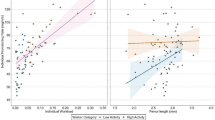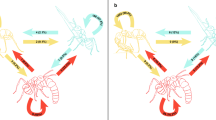Summary
Leaf cutting was selected for an evaluation of ergonomic efficiency in the fungus-growing ant Atta sexdens because it is performed largely by medias (head width 1.8–2.8 mm), which attend to relatively few other functions and hence are less likely to be evolutionarily compromised by the demands of competing tasks (Fig. 1).
Three alternative a priori criteria of evolutionary optimization were envisioned that are consistent with natura selection theory: the reduction of predation by means of defense and evasion during foraging, the minimization of foraging time through skill and running velocity during foraging, and energetic efficiency, which must be evaluated with reference to both the energetic construction costs of new workers and the energetic cost of maintenance of the existing worker force.
In order to measure the performance of various size groups within the A. sexdens worker caste in isolation, I devised the ‘pseudomutant’ technique: in each experiment, groups of foraging workers were thinned out until only individuals of one size class were left outside the nest. Measurements were then made of the rate of attraction, initiative in cutting, and performance of each size group at head-width intervals of 0.4 mm (Figs. 2, 3, and 7). Other needed measurements were made in body weight, oxygen consumption, and running velocity (Figs. 5, 6, and 8).
The size-frequency distribution ff leaf cutters in the A. sexdens conforms closely to the optimum predicted by the energetic efficiency criterion for harder forms of vegetation, such as rhododendron leaves. The distribution is optimum with reference to both construction and maintenance costs. The difference between the predicted and actual modal size groups specializing on leaf cutting is 10% or less of the total size range of the sexdens worker caste.
A model was next constructed in which attraction and initiative were allowed to ‘evolve’ genetically to uniform maximum levels. The theoretical maximum efficiency levels obtained by this means were found to reside in the head-width 2.6–2.8 mm size class, or 8% from the actual maximally efficiency class (head width 2.2–2.4 mm). In the activity of leaf cutting, A. sexdens can therefore be said to be not only at an adaptive optimum but also, within at most a relatively narrow margin of error, to have been optimized in the course of evolution.
Similar content being viewed by others
References
Alexander RMcN (1971) Size and shape. Arnold, London.
Cherrett JM (1972) Some factors involved in the selection of vegetable substrate by Atta cephalotes (L.) (Hymenoptera: Formicidae) in tropical rain forest. J Anim Ecol 41:647–660
Dobzhansky T, Levene H, Spassky B (1972) Effects of selection and migration on geotactic and phototactic behaviour of Drosophila, III. Proc R Soc (London) Biol 180:21–41
Ehrman L, Parsons PA (1976) The genetics of behavior. Sinauer Associates, Sunderland MA
Jensen TF, Nielsen MG (1975) The influence of body size and temperature on worker ant respiration. Nat Jutlandica 18:21–25
Oster GF, Wilson EO (1978) Caste and ecology in the social insects. Princeton University Press, Princeton
Wilson EO (1975) Sociobiology: the new synthesis. Belknap Press of Harvard University Press, Cambridge
Wilson EO (1980) Caste and division of labor in leaf-cutter ants (Hymenoptera: Formicidae: Atta). I. The overall pattern in A. sexdens. Behav Ecol Sociobiol 7:143–156
Author information
Authors and Affiliations
Rights and permissions
About this article
Cite this article
Wilson, E.O. Caste and division of labor in leaf-cutter ants (Hymenoptera: Formicidae: Atta). Behav Ecol Sociobiol 7, 157–165 (1980). https://doi.org/10.1007/BF00299521
Received:
Accepted:
Issue Date:
DOI: https://doi.org/10.1007/BF00299521




